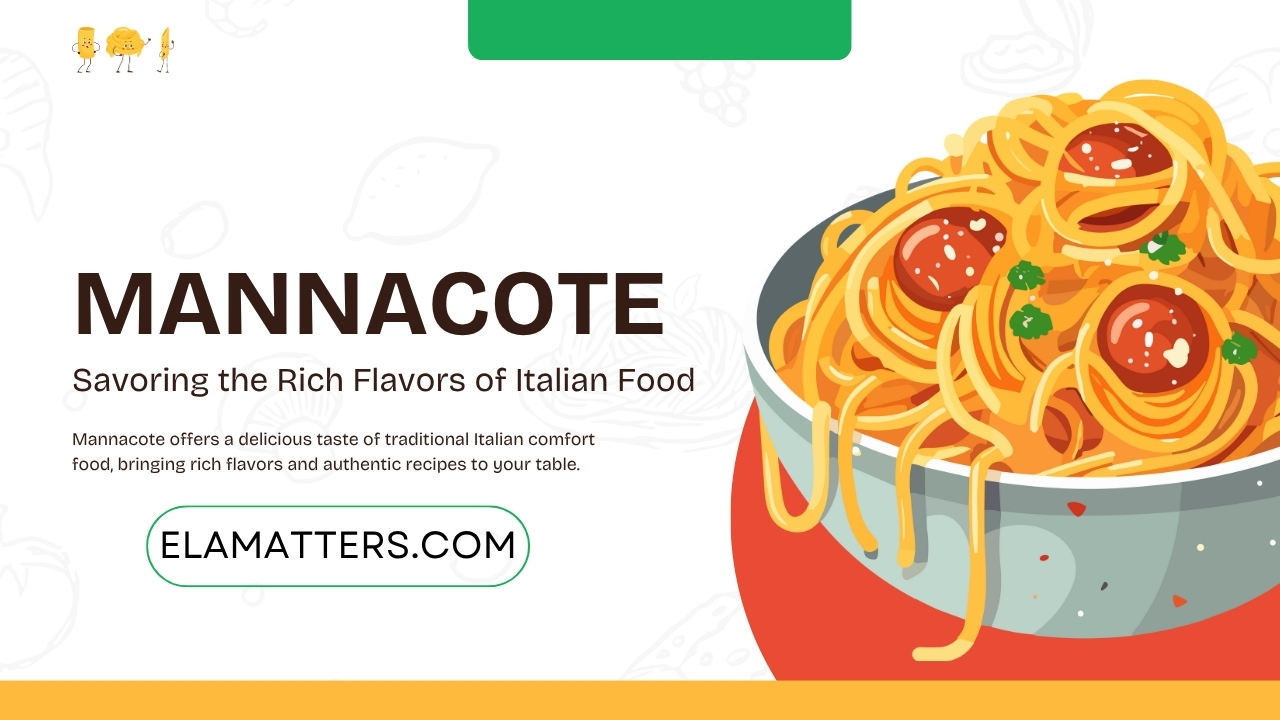Mannacote is more than just a word; it’s an invitation to dive into the heart of Italian culinary tradition. Picture vibrant markets overflowing with fresh produce, aromatic herbs wafting through sun-kissed streets, and family gatherings centered around laughter and shared meals. This rich tapestry of flavors tells a story that transcends generations, rooted deeply in Italy’s diverse regions. As we embark on this flavorful journey together, get ready to explore the key ingredients that define Italian cuisine and discover how every dish carries a piece of history within its essence. Whether you’re a seasoned chef or someone who simply enjoys good food, Mannacote serves as your gateway to savoring the true spirit of Italy.
The key ingredients in Italian cuisine
Italian cuisine is a celebration of fresh, high-quality ingredients. At its heart lies the concept of simplicity, allowing each component to shine.
Olive oil is essential. This golden liquid adds depth and richness to dishes while bringing health benefits too. It’s drizzled over salads or used as a base for sauces.
Tomatoes are another cornerstone. Whether sun-dried, crushed, or pureed, they provide vibrant flavor and sweetness that elevates any meal.
Herbs like basil and oregano bring aromatic notes that brighten up savory dishes. They are often found in sauces and marinades.
Cheeses such as Parmigiano-Reggiano and mozzarella add creaminess and texture to Italian favorites. Their unique characteristics enhance everything from pasta to pizza.
Don’t overlook garlic; its pungent aroma infuses countless recipes with warmth and zest. Together, these ingredients create the magic that defines Mannacote’s rich flavors!
Popular dishes from different regions of Italy
Italy boasts a diverse culinary landscape, with each region offering distinct flavors and ingredients. In the north, risotto from Lombardy is creamy and rich, often featuring saffron for that golden hue.
Travel south to Emilia-Romagna for lasagna al forno or tortellini in brodo, showcasing layers of pasta filled with savory meats and cheeses. The rich tomato sauce brings it all together.
Moving towards the coast, Campania’s pizza is world-renowned. Neapolitan-style pizza features a thin crust topped with fresh mozzarella and basil.
Sicily surprises food lovers with arancini—crispy rice balls stuffed with ragù or peas. This dish reflects the island’s Arabic influences.
In each bite, you can taste Italy’s history and regional pride. From hearty stews to light antipasti, every plate tells its own story infused with tradition and love for ingredients. Each meal becomes an exploration through time as well as taste sensations waiting to be discovered.
The role of pasta, pizza, and wine in Italian cuisine
Pasta, pizza, and wine are the heartbeats of Italian cuisine. They embody the essence of Italy’s culinary traditions.
Pasta comes in countless shapes and sizes. Each region boasts its specialties, from silky tagliatelle to robust orecchiette. Served with simple sauces or elaborate toppings, pasta is a canvas for flavors that dance on your palate.
Pizza represents a celebration of ingredients. Thin crusts topped with fresh tomatoes, creamy mozzarella, and fragrant basil create iconic Margherita pies. The art lies in balancing quality components while honoring tradition.
Wine plays an equally vital role at the table. It enhances meals and brings people together. From bold reds like Chianti to crisp whites such as Pinot Grigio, each sip complements a dish perfectly.
Together, these three staples tell stories passed down through generations—each bite revealing rich history and culture deeply rooted in Italian life.
Traditional cooking methods used in Italian food
Traditional Italian cooking methods are steeped in history and passion. Each technique reflects the culture and lifestyle of Italy’s regions.
Slow cooking is a hallmark. Dishes like ragù benefit from long simmering, which melds flavors beautifully. The result? Rich, hearty sauces that delight the palate.
Grilling is another essential method. Whether it’s vegetables or meats, grilling over open flames imparts a smoky depth that enhances natural flavors.
Baking also plays a crucial role, especially in making rustic breads and pizzas. The use of wood-fired ovens creates an unmatched crispiness on pizza crusts, offering a taste of authenticity.
There’s the art of hand-rolling pasta. This labor-intensive process gives each dish its unique texture and bite—something no store-bought option can replicate.
These methods connect Italians to their heritage while celebrating fresh ingredients in every meal they prepare with love.
Tips for savoring the flavors of Italian food
To truly savor Italian food, start by embracing the art of slow eating. Take your time with each bite, allowing the complex flavors to unfold on your palate.
Pairing is essential in Italian cuisine. Match dishes with complementary wines to enhance their taste. A rich red can elevate a hearty pasta sauce, while a crisp white may brighten seafood dishes.
Don’t shy away from fresh herbs and spices. Basil, oregano, and garlic are staples that bring depth to any meal. Use them generously for authentic taste experiences.
Consider the setting as well. Enjoy your meal al fresco when possible; it adds an element of relaxation that enhances flavor perception.
Don’t rush dessert—indulge in classic options like tiramisu or panna cotta. These sweet endings encapsulate the essence of Italian culinary artistry and make every dining experience memorable.
The health benefits of a Mediterranean diet
The Mediterranean diet offers a wealth of health benefits, primarily due to its rich array of fresh ingredients. This way of eating emphasizes whole foods like fruits, vegetables, legumes, and nuts.
These foods are packed with essential vitamins and minerals that support overall well-being. The focus on healthy fats—such as olive oil—has been linked to improved heart health.
Additionally, the diet encourages moderate consumption of fish and poultry while limiting red meat. This balance contributes to lower cholesterol levels and better cardiovascular function.
Moreover, the Mediterranean lifestyle promotes communal meals and mindful eating practices. These habits can enhance mental well-being by fostering social connections around food.
Embracing this diet not only nourishes the body but also enhances life quality through flavorful dishes brimming with nutrients.
How to recreate authentic Italian dishes at home
Recreating authentic Italian dishes at home is an art that anyone can master. Start with high-quality ingredients; fresh produce and imported staples make a significant difference. Opt for San Marzano tomatoes, Parmigiano-Reggiano cheese, and extra virgin olive oil.
Next, focus on traditional recipes. Explore classic dishes like risotto or osso buco, paying attention to the cooking techniques involved. Slow cooking enhances flavors beautifully.
Don’t skip pasta-making! Fresh pasta transforms any dish into something extraordinary. Invest in a simple pasta maker; it’s easier than you think.
Herbs are essential too. Use basil, oregano, and parsley liberally to infuse your meals with vibrant flavors reminiscent of Italy’s sun-drenched landscapes.
Embrace the communal aspect of dining by sharing these meals with family or friends. The joy of food multiplies when enjoyed together around the table—an experience quintessentially Italian.
Must-try dessert options in Italian cuisine
No Italian meal is truly complete without a nod to its delightful desserts. The world of Italian sweets is rich and varied, offering something for every palate.
Tiramisu stands as one of the most beloved Italian desserts worldwide. Its layers of coffee-soaked ladyfingers and mascarpone cream create an indulgent experience that’s hard to resist. Each bite transports you to a quaint café along the cobblestone streets of Rome.
Then there’s cannoli, originating from Sicily. These crispy pastry shells filled with sweet ricotta cheese are often adorned with chocolate chips or candied fruit. They provide a perfect crunch paired with creamy sweetness, making them an essential treat for any dessert lover.
Panna cotta is another gem that highlights Italy’s knack for simplicity in flavor combinations. This silky-smooth custard can be flavored with vanilla or citrus and served alongside fresh berries or caramel sauce, leaving your taste buds intrigued.
And let’s not forget about gelato! With its rich texture and vibrant flavors ranging from classic stracciatella to adventurous pistachio, gelato offers a refreshing way to end any meal on a hot summer day—or really any day!
Each dessert tells a story steeped in tradition and culture, embodying the passion Italians have for food—and life itself. Embrace these sweet offerings next time you indulge in Mannacote; they’re sure to leave you craving more delicious bites from this enchanting cuisine.

